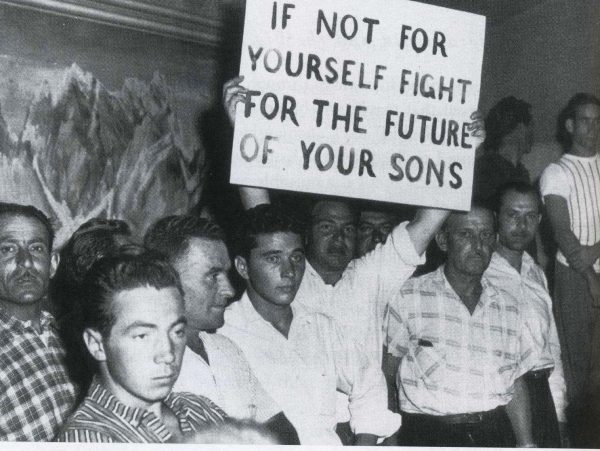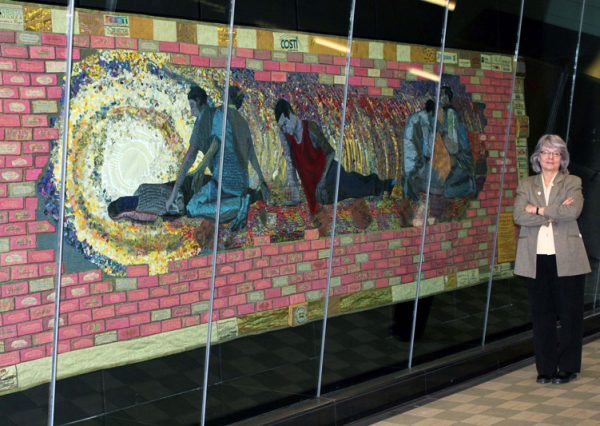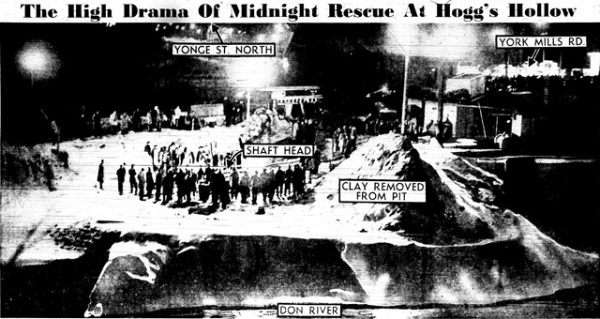The Hoggs Hollow Disaster, which occurred on March 17, 1960, killed five Italian immigrant workers: Pasquale Allegrezza, Giovanni Correglio, Giovanni Fusillo, and brothers Alessandro and Guido Mantella. They were clearing a tunnel about 12 metres below ground to create overflow ditches in the aftermath of Hurricane Hazel. The men had no hard hats, fire extinguishers, or resuscitators; they were working in a tunnel less than two metres in diameter, and had to crawl under a 36-inch watermain to pass each other.
Soft tunnelling conditions required the use of air pressure many times higher than normal to stop cave-ins and the entry of dirt and silt. The first contractor with a winning (but unrealistically low) bid went broke, and the bonding agency that took over the contract sped up the work, extended the pressurized parts of the tunnel, and ignored numerous fires in the oxygen-rich environment. Safety regulations were flouted, and the workers had no union.
The tragedy occurred after a spark from a cutting torch ignited a rubberized cable and six men found themselves trapped behind a wall of poisonous smoke. The air pressure was cut off, causing a cave-in of silt and water. A valve to blow the smoke out of the tunnel would not open, and timber supports holding the tunnel partially collapsed. Only one worker — Walter Andruschuk — was able to escape.
For days, the public learned more details about the tragedy. The crusading journalist Frank Drea exposed the terrible negligence in front page stories of the Toronto Telegram that shocked Torontonians. Autopsies determined the deaths were by drowning and carbon monoxide poisoning.

The event sparked a fury within the Italian community that had seen far too many deaths in a ruthless construction industry. Within weeks, a series of meetings drew thousands of disgruntled workers demanding workplace justice, and strikes took place demanding union recognition. The next year, a massive strike wave saw a rally of 17,000 construction workers held at the CNE Stadium. The activism of the community and the labour movement finally led to a Royal Commission on health and safety, and, ultimately, new legislation to protect workers.
For the Italian community, the response to the Hoggs Hollow disaster was also reflected in a desire to make Toronto a place where they were no longer treated as second class citizens. They started challenging widespread discrimination in their neighbourhoods, in workplaces and at the Workers Compensation Board, as well as the treatment meted out to their children in schools.
Forty years later, COSTI Immigrant Service and labour groups sponsored a commemorative quilt, designed by artist Laurie Swim, featuring images of the five men. On March 17, 2000, hundreds of construction workers left their work on the Sheppard Subway project to attend a ceremony at the Hoggs Hollow location, organized by the Toronto Central Ontario Building Trades Council. They heard eyewitness accounts from Drea as well as rescuers Nester Buchinski and John Barrett, who had volunteered to enter the smoke filled tunnel to try to save the trapped men. And finally, the City of Toronto placed a plaque on Yonge Street to recognize the event.

On the 50th anniversary, the quilt was formally inaugurated at the York Mills Subway station to honour their memory.
Today, construction workers have strong unions and far better safety conditions because of the struggles that followed the Hoggs Hollow tragedy. To learn more about working people’s history in Toronto go to www.labour150.ca.
John Cartwright is past President of the Toronto & York Region Labour Council. A carpenter by trade, he organized the Hoggs Hollow memorial ceremony on March 17, 2000.


